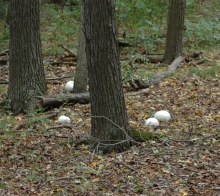ABSTRACTBiodiversity has been shown to vary across gradients of human influence in a number of different ways. For instance, previous ecological research has demonstrated that the number of unique species (i.e. species richness) declines as the amount of impervious surface on the land increases. Conversely, other studies have shown that species richness peaks at moderate levels of human influence when using a measurement such as the number of houses. Since the 1970s ecologists have measured a number of different human influence measures (e.g., human population, number of houses, percent impervious surface) to explore how biodiversity patterns change, yielding three basic types of relationships. These three relationships are the: 1) Productivity Hypothesis, in which diversity increases with human influence; 2) Intermediate Disturbance Hypothesis, in which diversity is greatest at an intermediate level of human influence; and, 3) Ecosystem Stress Hypothesis, in which diversity declines with increasing human influence. The overall goal of this semester-long laboratory exercise is to collect data from various positions along a human influence gradient and synthesize it in order to provide support for one of the three hypotheses. Over the course of the semester students learn to conduct biological inventories, keep field notebooks, use field guides and taxonomic keys, synthesize and analyze data, and produce poster and journal article products. AUTHORSChristopher A. Lepczyk Department of Natural Resources and Environmental Management, University of Hawai‘i at Mānoa, Honolulu, HI 96822. lepczyk@hawaii.edu CLASS TIMETwo to three hours per week, full semester. OUTSIDE OF CLASS TIMEOn average, a student will need 3-6 hours of time outside the classroom each week devoted to a component of the project. During this time, the students analyze data, conduct literature reviews, write up the work in both poster and manuscript formats. STUDENT PRODUCTSStudents are assessed on: 1) field notebook; 2) poster presentation; and, 3) draft and final paper written in format of Ecology. SETTINGThe labs are carried out along gradients from rural (or pristine) sites to urban (city center or human-dominated) sites and can be sampled in a variety of orders. The labs can be conducted at any season as long as the instructor is aware of what species can be identified in the field at a given time of year. However, the lab works a bit easier during spring through autumn. The number of different points along the gradient to sample should ideally be at least five, in order to have enough data points to provide support for the hypotheses being tested. Data processing and analyses take place in the lab. COURSE CONTEXTThis lab was taught in the General Ecology (Biological Sciences 310) course in the Biological Sciences Department at the University of Wisconsin-Milwaukee. The course contained 80 students, who were divided into sections of 20 for three hour laboratories once per week. Within each lab section the students were divided into groups of five students each based upon a random draw of four different colored suckers, resulting in 16 groups across all laboratory sections. All students participated in the lab. Labs were run by the instructor with one graduate student teaching assistant that was competent in identifying species of at least one taxonomic group (e.g., trees, birds, small mammals). INSTITUTIONI teach at a large research institution. TRANSFERABILITYThis lab can be easily altered to add more material, labs, or ideas, thus creating a more in-depth experience for advanced students. Similarly, the lab can be reduced to a project that takes only several sessions, if simply trying to look at the relationship on the gradient and the instructor synthesizes the data. Furthermore, the lab can be used to investigate relationships along a gradient and not as a strict test of three hypotheses. The lab can easily be transferred to non-majors classes and any location where a gradient is in close proximity to an institution. Students with disabilities can participate throughout, but may have more challenges in field settings, depending upon the nature of a given location. Finally, the lab can be run in a pre-college or introductory division course if the instructor takes a more active role in modifying or assisting with the lab or it is reduced in scope. ACKNOWLEDGMENTSThe origin of this laboratory arose when I held a one year Visiting Assistant Professorship at the University of Wisconsin-Milwaukee (UWM) from 2005-2006 in which I taught General Ecology 310. During the previous decade the laboratory component of the ecology course had been revamped with support from the National Science Foundation to focus on testing one general ecological relationship or theory. Prior to my arrival the general relationship investigated had always been the River Continuum Concept (RCC). As an ecologist with a focus on landscape ecology and applied questions, I was charged with reinvigorating the lab to a wider audience that had an applied focus (which was important given the urban nature of the campus and student body). The primary individual responsible for developing the idea of a single semester long laboratory at UWM, and mentor for my development of this current lab, was Timothy Ehlingher, an Associate Professor in the Biological Sciences Department at UWM. In addition, my inspiration for this laboratory and its various components were my two undergraduate mentors from Hope College, Kathy Winnett-Murray and K. Greg Murray. I would also like to thank Neil Beckman and Brianna McDowell who served as inspirational teaching assistants for the first running of this laboratory. Finally, Christopher Beck and two anonymous reviewers provided a number of valuable thoughts that helped to improve the clarity of the laboratory. CITATIONChristopher A. Lepczyk. February 23 2009, posting date. Biodiversity Responses across a Gradient of Human Influence. Teaching Issues and Experiments in Ecology, Vol. 6: Experiment #4 [online]. http://tiee.ecoed.net/vol/v6/experiment/biodiversity_responses/abstract.html |

full size image
A picture of a forest plot from the UWM Field Station, illustrating the low human influence site in the study, and a picture of downtown Montreal, illustrating high human influence (note that Montreal is used for descriptive purposes here and was not part of the study). Pictures by C.A. Lepczyk. |
<top> | |
